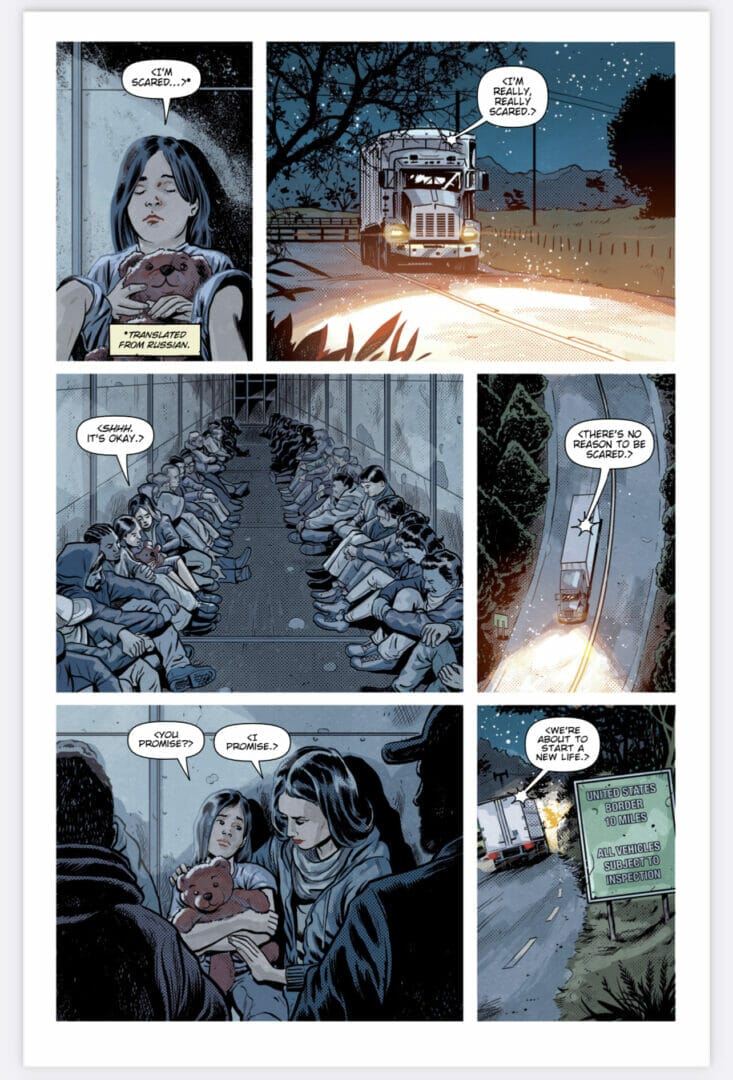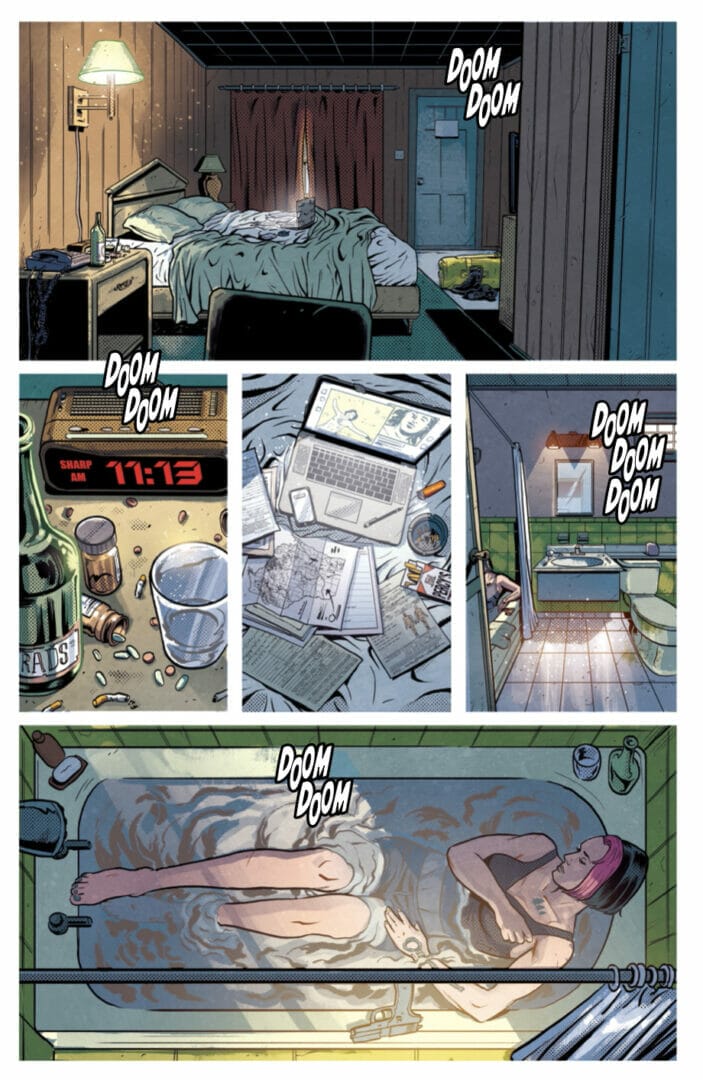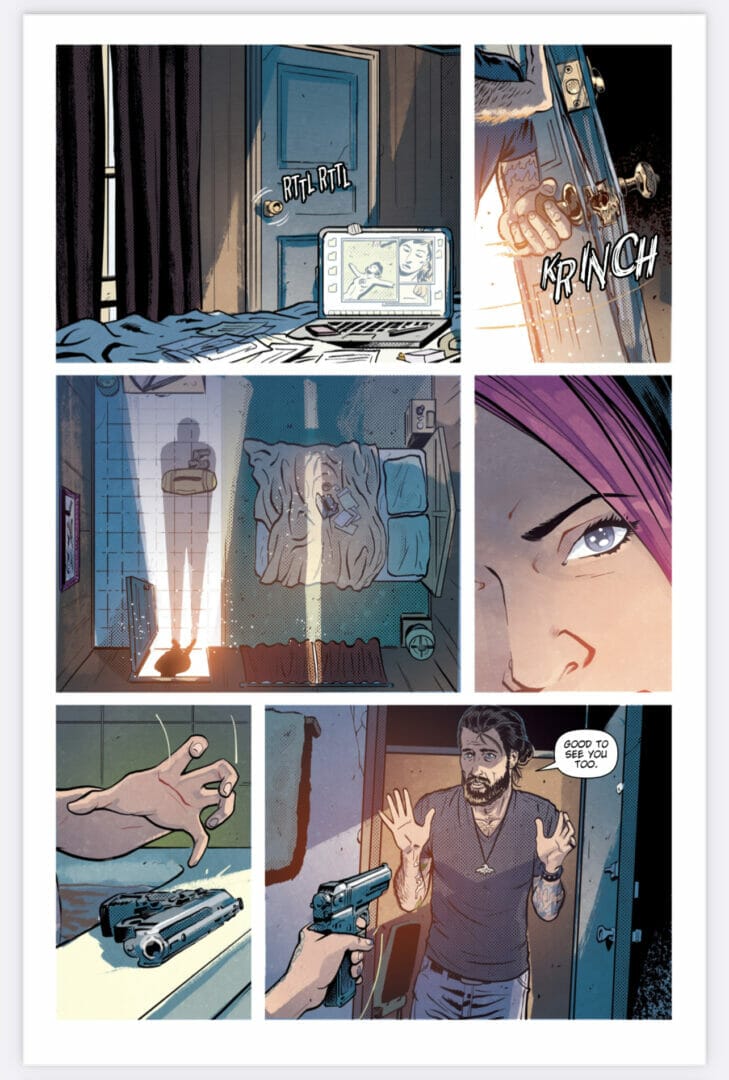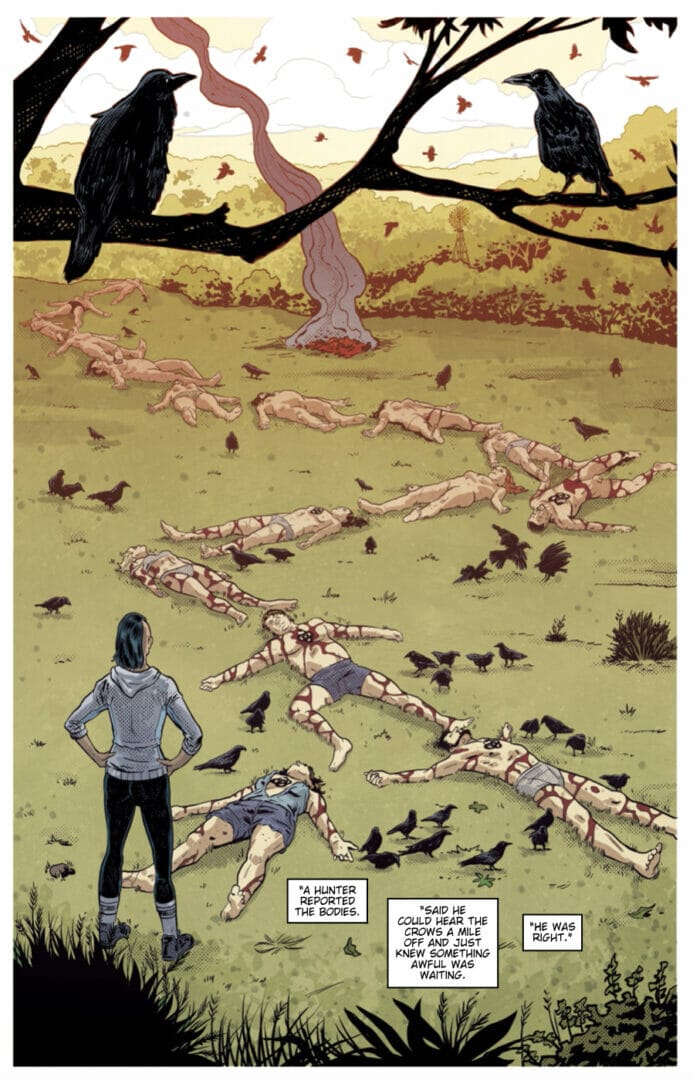The Nerdy Basement had the incredible opportunity to sit down with Devil’s Highway creators Benjamin Percy and Brent Schoonover and ask a few questions, and Troy took up the challenge. Enjoy!
Set in the American Mid-West, Devil’s Highway follows Sharon Harrow and Quentin Skinner as they try to unravel the mystery of bodies stacked in trucks, murder syndicates, and paranoia. The AWA Studios publicized comic, created by Ben Percy and Brent Schoonover, returns this year with Devil’s Highway Volume Two, and it is gearing up to dive deeper into the seedy underbelly of an invisible world while upping the ante for the protagonists.
THE NERDY BASEMENT: Hey guys, hope you’re doing well in the new year. Thanks so much for taking the time to be interviewed. I thoroughly enjoyed the first volume of Devil’s Highway and was super excited to hear the announcement of a second. I read the first issue and you’ve got me hooked already, well done! I’ve gathered some questions for you today.
THE NERDY BASEMENT: What would you order for your last meal? You can include drinks.
Brent Schoonover: I’d have to go with a steak dinner and a nice old-fashioned.
Ben Percy: Filet Mignon, Caesar salad, hashbrowns, French bread, and a bottomless Manhattan. Then you can roll me over to the firing squad.
THE NERDY BASEMENT: Looks like we have some steak connoisseurs on our hands. Leading from that into a gruesome segue: The world is obsessed with murder mysteries. Every other week there’s a new docuseries or British crime drama, but you have brought that formula to the written page. What is your planning strategy, Ben? Do you start with a single idea or begin with the ending? And similarly, Brent, do you have the script written first, or do you have ideas that might sway the story in some way?
Brent Schoonover: Ben and I often get together to go over story ideas, or at least chat on the phone. I like to be involved in throwing out where I think we can and should go with the overall story. But much how I don’t really like having every little detail of a panel explained to me in a script, I don’t want Ben to feel like he’s got to write everything I suggested in our chats. A perfect example is I think we both knew where we wanted Volume Two to end, but I just read the script for Issue Five recently and I had no clue how we were getting there. And I loved it. And I loved that it wasn’t just Ben hitting preconceived bullet points.
Benjamin Percy: It’s always essential to know your ending when you begin a story. Then every paragraph (if it’s a novel) or every panel (if it’s a comic) is like a domino crashing forward, transferring its momentum to that final moment. With that said, I don’t want to plan in advance every single thing that happens—or I’d be bored in the telling. I like to think of my outlines as constellations. I know the brightest stars and the artist, and I fill in the dark spaces between them.
But to be more particular—as to where this season of Devil’s Highway came from—I was inspired in part by several headlines involving semi-trailers and ship containers stacked with bodies, the result of failed attempts at human trafficking.


THE NERDY BASEMENT: Ben, I love your analogy about the brightest stars. It must be amazing for you both to work with someone you trust. And that must come in handy when you’re creating character elements. For example, Sharon is a hard character. Or as Candy puts it during Volume One “a crazy-ass bitch”. As writers, we feel it is important for characters to take some ownership throughout the story rather than it being plot central. Did any plot points change within either Volume One or Two because Sharon ‘decided’ to do something else?
Brent Schoonover: I’ll let Ben answer that.
Ben Percy: I think of character first, plot second. The plot is the aftermath of a character’s decisions. So in the case of Sharon, I always had to ask if a move was authentic to her personality. She’s traumatized (by her mother’s suicide, by her father’s murder, by her time fighting abroad), and so she puts up shields in all interactions because she doesn’t ever want to be vulnerable. As a result, she won’t ever articulate that she cares for other people. In this second season, she abandons Quentin Skinner. Rather cruelly after all they’ve been together. But she actually does this because she cares about him and wants to keep him safe. So I’m always interpreting the story through the difficult lens of her mind, and sometimes that actually makes for a more troubled story, because she’s not going to take the easy route.
THE NERDY BASEMENT: It’s interesting that you mention her trauma almost controlling her actions because it is something we sometimes see in the media, albeit not always accurately, and sometimes we forget people are also dealing in our real-life interactions. A lot of Volume One takes place in a seedy underbelly environment, which you continue in Volume Two. With the risk of sounding cliche, the setting almost becomes a character unto itself (Gotham, am I right, Brent?). I’d like an insight from both of you on this, what do you perceive are the important pieces to creating a setting that comes to life?
Brent Schoonover: I think the environment for Devil’s Highway comes from Ben and I being full-on Midwesterners and living in or around these types of places for almost our entire lives. Gotham City is just a fun place to draw, so it’s easy to get excited drawing gargoyles on every building. I don’t know too many artists who get excited rendering the Midwest, with its dingy gas stations and greasy spoons, but they are my favorite places to set a story, cause I know them so well being around them my entire life. One of my favorite things with Volume One is how much people have complimented my attention to the environments and locations. I think I upped my game on that. And I think it easily had to do with the fact that I knew those places well and was excited to bring them to life in the comic.
Ben Percy: We live in the north. Some people consider this to be a flyover country, but it’s central to our identity and our imaginative life. We wanted to capture it authentically and make it a stage for our storytelling, shine a light on a place that’s often relegated to the shadows.
THE NERDY BASEMENT: The symbolism of the snake features heavily across many cultures and its meaning ranges from lies, evil, and temptation all the way to fertility, rebirth, or immortality. For those readers yet to read Devil’s Highway, what drew you towards using the ouroboros as a centerpiece of both tales?
Ben Percy: The FBI believes there are a dozen or so serial killers operating as long-haul truckers right now. This was the trigger for creating the world of Devil’s Highway. What if they weren’t operating on their own, but as part of a murder syndicate? The way the roads snake along—slick and black with yellow banding upon them—made me think of snakes. And so I leaned into this as a way to visually anchor this collection of killers: the snake is their weapon, their mascot, their identity. We get deeper into this mythology in the second volume.
THE NERDY BASEMENT: Of course! I didn’t pick up on the metaphor of the road representing a serpent; that’s very eloquent. I will put some research into the FBI’s thoughts too. I think it’s important to understand the world we live in and not take everything at face value. Devil’s Highway focuses a lot on drawing the reader into an almost familiar situation (i.e. a diner or inspection of a truck) and then shocking them with a visually disturbing scene. Brent, what are your processes for illustrating such juxtaposing images? Are you focusing on color, positioning, and facial expressions? I’d love to get your insight.
Brent Schoonover: I’d say Devil’s Highway was the first book I’ve done that had little to no influence from other comic books. Obviously, as an artist, I do have influences from comic artists in how I render. It’s common when you work on a well-known character to pull out your favorite issues or graphic novels of that character and try to suck in all the history and figure out how you want your version of that character to be. Pulling what you like from here and there. I didn’t pull out any comics for this book. I watched movies like Seven and Zodiac.
Making a Murderer had just come out while we were developing the first series and the locations and people really influenced me on how the people and places should look. This book needs to pull from real life. I remember getting a note from Axel on a panel and its composition that simply said, “too superhero, make it real.” And he was totally right. It needed to be grounded.
So finding that balance and using a panel grid layout method that we have, where it’s not exactly a nine-panel layout, but there are certain rules on how we do things with the borders, that restrict this story from going big with the layouts, that paces it nice and slow, but when we need to, we can switch it up a bit. I think it’s exactly the way this story needed to be done. Otherwise, it kind of becomes the same as everything else on the stands.
THE NERDY BASEMENT: I have a killer soft spot for silhouetted imagery, and the cover art for Volume One had me. It captures the grittiness of the series and it looks like this will be continued. What helps and inspires you, Brent, to capture the essence of a single issue and portray that through the cover?


Brent Schoonover: Again, nothing from comics has really influenced much of this book. I wanted each cover from the first volume to feel like a movie poster. And I too am a big fan of silhouetted imagery and monochromatic imagery. I think you can get the best results by limiting your options sometimes. And kudos to Nick Filardi for knocking the colors out of the park on everything. I think Issue Three of Devil’s Highway Volume One is one of the best images I’ve ever done. I love that cover. For Volume Two, Tarot cards play a role, so we are using the structure of those for our covers of this volume. My challenge for these covers was: that it would be easy to just have trucks on a road for each issue, but let’s get a little deeper. So far I’ve been very happy with the results.
THE NERDY BASEMENT: And you should be! This could be a question for either of you. As I was reading, I felt as if I was watching a TV show or film; the way my eye carries through the page, not only following the panels but also as if there is an intended movement. I’m thinking about the mid shots, close-ups, and in particular the action sequence of Volume Two, Issue #1 pages 16-18. How do these come about and what is the thought process behind how each action carries through multiple panels across a page?
Brent Schoonover: Pretty sure this was very early on in the process, but Ben mentioned that while we have this awful group of people that are doing terrible things, Sharon is the one that truly attacks like a snake. She’s so quiet and unemotional, but she’s super calculated and always reading a room or environment for when she needs to attack or exit. So you have these small simple panels and then boom, she’s in full-on ass-kicker mode. Hopefully, it catches the readers off guard and makes you feel like you never really know when things are about to pop off.
Ben Percy: It’s sometimes harder to get away with the cinematic reel when you’re writing for Marvel and DC—because issues are expected to pack in so much mayhem. I wanted to be more slow, patient, gritty, and real with this series. I also very intentionally cut back on narration (which I use heavily in my Marvel work) and rely mainly on the image and dialogue to tell the story. You feel like you’re living Devil’s Highway with the characters as a result—rather than being told a story—and I hope that contributes to the suspense.
THE NERDY BASEMENT: Another great juxtaposition thereof the villain’s approach versus Sharon’s. I think the cutback on narration was a nuanced choice, it really perpetuates the tone. An interesting point when comparing Marvel or DC to something like this. I love those comics and characters, especially the MCU, and I know they have their audience but I think it would be a nice challenge for them to approach the stories a little differently sometimes. Obviously, the villains throughout are conducting their business as truckers. Have you had any feedback, positive or negative, from actual truckers who have read the story? What other “invisible” parts of the world would you both like to explore?
Ben Percy: I have indeed heard from truckers—online and at conventions. They all thanked me for going deep on the details and capturing their world, a world people don’t oftentimes pay any attention to. So far, nobody has been angry, but who knows: maybe I’m the next on the list for the murder syndicate.
Brent Schoonover: I’ve had a few truckers reach out. Pretty much all positive. Some suggestions on terminology and technology actually. Which is great. As for other parts of the invisible world, that’s a good question but I’d hate to answer cause we might just get to them. As you see as this story progresses. I will say, we are about to meet one of my favorite new allies to Sharon and Skinner in this series and I love this character very much. I hope we get to do more with them.
Ben Percy: This country would not function without truckers, so we wanted to make sure we showed the positive side of the industry (along with all the crazy stuff that can happen in its underbelly). There’s a character in this season—a female trucker named Pancake—who you can’t help but rally around.
THE NERDY BASEMENT: That must be so encouraging to have that positivity come from the world you’re writing about. It’s so easy for people to become offended but when they’re also coming from a place of education or thanks, it must be so uplifting. In Australia, there is an infamous serial murderer named Ivan Milat. During the early 90s, he was the perpetrator of multiple deaths of backpackers. The story behind a trucker serial killer felt eerily similar to me. Did you grab any references or inspiration from real life for your story?
Brent Schoonover: The entire concept of Devil’s Highway got going from having a nice breakfast with Ben, and chatting about true crime stuff we were digging on. I am familiar with the story of Ivan Milat. I can’t say he was directly on our minds when thinking about creating this but I’m sure it was in the back of my head at least a little bit. A lot of it came from the concept of the Smiley Face Killers theory. This has never been proven but it’s crazy how many well-respected officers and agents do acknowledge there’s some weight to the evidence that it may be true.
Ben Percy: Yeah, we were thinking more of the Smiley Face Killer, who is said to operate along Interstate corridors. But Ivan Milat is a great topic for getting lost down an internet rabbit hole as well.
THE NERDY BASEMENT: Ok, I just did a quick Google search because I had not heard of the Smiley Face Killer and that is incredibly dark yet intriguing. No wonder you guys took inspiration from that world. The fact the police had the theory but it’s only that, is such a mystery. I will definitely be researching more. Thanks! Brent, you designed the poster for Elton John’s Farewell Yellow Brick Road tour. I’m a huge fan of his music (in fact, Can You Feel The Love Tonight was the first dance song at my wedding [not the Lion King version!]) but it got me thinking about a question for you both. If you were to have a full stadium, standing-ovation type farewell tour, what song would be playing as you walked on stage?
Brent Schoonover: Yakety Sax. The theme from The Benny Hill Show.
THE NERDY BASEMENT: Haha! I hope it comes complete with a full chase scene as you run in and out of curtains or dressing rooms. There are many hints and drops throughout the story of Volume One, i.e. the black dots on the tongue, and the tattooed noose linking Sharon’s past. Should we be expecting more of these? I was trying to spot them in Issue One.


Brent Schoonover: I think our next focus and clue drop is mostly focused on Astrology. It gives a bigger meaning to our cult of snakes. Sharon’s noose is clearly related to her mom’s suicide. I’d love to explore that and her father’s relationship a bit more if we get the chance to tell more stories. I’d love to see how Sharon left home and joined the military, and how her military experience worked out or didn’t. We give glimpses in Volume One, but I’d love to expand on it.
Ben Percy: There is a constellation—known as Serpens—that provides a ticking clock and contributes to the mythology of the second season. Keep your eyes peeled for clues.
THE NERDY BASEMENT: So, what’s on the cards for you both coming up? And, with your previous answers, it seems Tarot cards have also been turning up in your lives. Obviously, Devil’s Highway is your current work but are either of you involved in the upcoming AWA shared universe or some other projects to look out for?
Brent Schoonover: I am drawing Captain America: The Ghost Army for Marvel/Scholastic. Should be out early next year. Written by Alan Gratz
Ben Percy: I’m writing Wolverine, X-Force, and Ghost Rider for Marvel. I’m also publishing several novels presently that are part of a shared universe called The Comet Cycle. And I’m busy in film and TV, including adapting Urban Cowboy for Paramount Plus.
THE NERDY BASEMENT: You’re both very busy! Before we finish up, can you give any advice to those comic book fans who might want to follow in your footsteps as a writer or artist in this world?
Brent Schoonover: From an artist’s standpoint I say don’t wait to collaborate. If you aren’t finding anyone to work with, make your own comics. Put them online. It may take a while to gain an audience but if you stick with it, you will see growth in your work and that should lead to a growth in readers.
Ben Percy: Most writers break-in in one of two ways. They succeed in other storytelling mediums (like novels, tv) and then enter through the side door of comics. Or they start off publishing indie comics with small presses or online—and then work their way up the ladder. Everything in my career has been incremental, so start small and bully your way forward from there.
THE NERDY BASEMENT: And there you have it, folks. Another huge thank you to the boys for providing such extensive answers throughout the interview. They certainly provide another viewpoint to the Devil’s Highway story and add extra elements for me, and you, to enjoy. As stated, the second volume of Devil’s Highway will be launched with Issue #1 on May 4th. It is looking to be another truly suspenseful and haunting experience, akin to True Detective. Get your copy asap!
Want to discuss things further? Hit us up on Twitter, Facebook, or Instagram. And for more film, gaming, anime, and TV news, trailers, and updates make sure to keep it locked right here at The Nerdy Basement. While you’re here, please consider supporting us on Patreon! It’s an easy way of supporting us so we can keep providing you with your Nerdy News!

